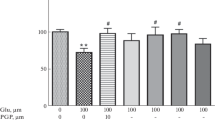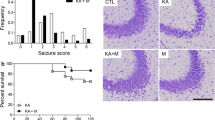Abstract
KB-R7943, an inhibitor of a reversed Na+/Ca2+ exchanger, exhibits neuroprotection against glutamate excitotoxicity. Taking into consideration that prolonged exposure of neurons to glutamate induces delayed calcium deregulation (DCD) and irreversible decrease of mitochondrial membrane potential (Δψmit), we examined the effect of KB-R7943 on glutamate and kainate-induced [Ca2+]i and on Δψmit changes in rat cultured cerebellar granule neurons. 15 μmol/l KB-R7943 significantly delayed the onset of DCD in response to kainate but not in response to glutamate. In spite of [Ca2+]i overload, KB-R7943 considerably improved the [Ca2+]i recovery and restoration of Δψmit after glutamate and kainate washout and increased cell viability after glutamate exposure. In resting neurons, KB-R7943 induced a statistically significant decrease in Δψmit. KB-R7943 also depolarized isolated brain mitochondria and slightly inhibited mitochondrial Ca2+ uptake. These findings suggest that mild mitochondrial depolarization and diminution of Ca2+ accumulation in the organelles might contribute to neuroprotective effect of KB-R7943.








Similar content being viewed by others
References
Blaustein MP, Lederer WJ (1999) Sodium/calcium exchange: its physiological implications. Physiol Rev 79:763–854
Guerini D, Coletto L, Carafoli E (2005) Exporting calcium from cells. Cell Calcium 38:281–289
Iwamoto T, Watano T, Shigekawa M (1996) A novel isothiourea derivative selectively inhibits the reverse mode of Na+/Ca2+ exchange in cells expressing NCX1. J Biol Chem 271:22391–22397
Amran MS, Homma N, Hashimoto K (2003) Pharmacology of KB-R7943: a Na+-Ca2+ exchange inhibitor. Cardiovasc Drug Rev 21:255–276
Watanabe Y, Koide Y, Kimura J (2006) Topics on the Na+/Ca2+ exchanger: pharmacological characterization of Na+/Ca2+ exchanger inhibitors. J Pharmacol Sci 102:7–16
Iwamoto T (2007) Na+/Ca2+ exchange as a drug target–insights from molecular pharmacology and genetic engineering. Ann N Y Acad Sci 1099:516–528
Schroder UH, Breder J, Sabelhaus CF et al (1999) The novel Na+/Ca2+ exchange inhibitor KB-R7943 protects CA1 neurons in rat hippocampal slices against hypoxic/hypoglycemic injury. Neuropharmacology 38:319–321
Breder J, Sabelhaus CF, Opitz T et al (2000) Inhibition of different pathways influencing Na(+) homeostasis protects organotypic hippocampal slice cultures from hypoxic/hypoglycemic injury. Neuropharmacology 39:1779–1787
Li S, Jiang Q, Stys PK (2000) Important role of reverse Na(+)-Ca(2+) exchange in spinal cord white matter injury at physiological temperature. J Neurophysiol 84:1116–1119
MacGregor DG, Avshalumov MV, Rice ME (2003) Brain edema induced by in vitro ischemia: causal factors and neuroprotection. J Neurochem 85:1402–1411
Luo J, Wang Y, Chen X et al (2007) Increased tolerance to ischemic neuronal damage by knockdown of Na+-Ca2+ exchanger isoform 1. Ann N Y Acad Sci 1099:292–305
Stys PK, Waxman SG, Ransom BR (1992) Ionic mechanisms of anoxic injury in mammalian CNS white matter: role of Na+ channels and Na(+)-Ca2+ exchanger. J Neurosci 12:430–439
Hoyt KR, Arden SR, Aizenman E et al (1998) Reverse Na+/Ca2+ exchange contributes to glutamate-induced intracellular Ca2+ concentration increases in cultured rat forebrain neurons. Mol Pharmacol 53:742–749
Kiedrowski L, Brooker G, Costa E et al (1994) Glutamate impairs neuronal calcium extrusion while reducing sodium gradient. Neuron 12:295–300
Kiedrowski L, Czyz A, Baranauskas G et al (2004) Differential contribution of plasmalemmal Na/Ca exchange isoforms to sodium-dependent calcium influx and NMDA excitotoxicity in depolarized neurons. J Neurochem 90:117–128
Czyz A, Kiedrowski L (2002) In depolarized and glucose-deprived neurons, Na+ influx reverses plasmalemmal K+ -dependent and K+ -independent Na+/Ca2+ exchangers and contributes to NMDA excitotoxicity. J Neurochem 83:1321–1328
Martinez-Sanchez M, Striggow F, Schroder UH et al (2004) Na(+) and Ca(2+) homeostasis pathways, cell death and protection after oxygen-glucose-deprivation in organotypic hippocampal slice cultures. Neuroscience 128:729–740
Kiedrowski L (2007) Critical role of sodium in cytosolic [Ca2+] elevations in cultured hippocampal CA1 neurons during anoxic depolarization. J Neurochem 100:915–923
Kim YT, Park YJ, Jung SY et al (2005) Effects of Na+-Ca2+ exchanger activity on the alpha-amino-3-hydroxy-5-methyl-4-isoxazolone-propionate-induced Ca2+ influx in cerebellar Purkinje neurons. Neuroscience 131:589–599
Floyd CL, Gorin FA, Lyeth BG (2005) Mechanical strain injury increases intracellular sodium and reverses Na+/Ca2+ exchange in cortical astrocytes. Glia 51:35–46
Kintner DB, Luo J, Gerdts J et al (2007) Role of Na+-K+-Cl- cotransport and Na+/Ca2+ exchange in mitochondrial dysfunction in astrocytes following in vitro ischemia. Am J Physiol Cell Physiol 292:C1113–C1122
Wu MP, Kao LS, Liao HT et al (2008) Reverse mode Na+/Ca2+ exchangers trigger the release of Ca2+ from intracellular Ca2+ stores in cultured rat embryonic cortical neurons. Brain Res 1201:41–51
Ouardouz M, Zamponi GW, Barr W et al (2005) Protection of ischemic rat spinal cord white matter: Dual action of KB-R7943 on Na+/Ca2+ exchange and L-type Ca2+ channels. Neuropharmacology 48:566–575
Araujo IM, Carreira BP, Pereira T et al (2007) Changes in calcium dynamics following the reversal of the sodium-calcium exchanger have a key role in AMPA receptor-mediated neurodegeneration via calpain activation in hippocampal neurons. Cell Death Differ 14:1635–1646
Arakawa N, Sakaue M, Yokoyama I et al (2000) KB-R7943 inhibits store-operated Ca(2+) entry in cultured neurons and astrocytes. Biochem Biophys Res Commun 279:354–357
Sobolevsky AI, Khodorov BI (1999) Blockade of NMDA channels in acutely isolated rat hippocampal neurons by the Na+/Ca2+ exchange inhibitor KB-R7943. Neuropharmacology 38:1235–1242
Santo-Domingo J, Vay L, Hernandez-SanMiguel E et al (2007) The plasma membrane Na+/Ca2+ exchange inhibitor KB-R7943 is also a potent inhibitor of the mitochondrial Ca2+ uniporter. Br J Pharmacol 151:647–654
Kraft R (2007) The Na+/Ca2+ exchange inhibitor KB-R7943 potently blocks TRPC channels. Biochem Biophys Res Commun 361:230–236
Khodorov BI, Storozhevykh TP, Surin AM et al (2002) The leading role of mitochondrial depolarization in the mechanism of glutamate-induced disruptions in Ca2+ homeostasis. Neurosci Behav Physiol 32:541–547
Brustovetsky N, Brustovetsky T, Jemmerson R et al (2002) Calcium-induced cytochrome c release from CNS mitochondria is associated with the permeability transition and rupture of the outer membrane. J Neurochem 80:207–218
Huser J, Rechenmacher CE, Blatter LA (1998) Imaging the permeability pore transition in single mitochondria. Biophys J 74:2129–2137
Shalbuyeva N, Brustovetsky T, Brustovetsky N (2007) Lithium desensitizes brain mitochondria to calcium, antagonizes permeability transition, and diminishes cytochrome C release. J Biol Chem 282:18057–18068
Li T, Brustovetsky T, Antonsson B et al (2008) Oligomeric BAX induces mitochondrial permeability transition and complete cytochrome c release without oxidative stress. Biochim Biophys Acta 1777:1409–1421
Tymianski M, Charlton MP, Carlen PL et al (1993) Secondary Ca2+ overload indicates early neuronal injury which precedes staining with viability indicators. Brain Res 607:319–323
Castilho RF, Hansson O, Ward MW et al (1998) Mitochondrial control of acute glutamate excitotoxicity in cultured cerebellar granule cells. J Neurosci 18:10277–10286
Hack N, Balazs R (1995) Properties of AMPA receptors expressed in rat cerebellar granule cell cultures: Ca2+ influx studies. J Neurochem 65:1077–1084
Rego AC, Ward MW, Nicholls DG (2001) Mitochondria control ampa/kainate receptor-induced cytoplasmic calcium deregulation in rat cerebellar granule cells. J Neurosci 21:1893–1901
Matsuda T, Arakawa N, Takuma K et al (2001) SEA0400, a novel and selective inhibitor of the Na+ -Ca2+ exchanger, attenuates reperfusion injury in the in vitro and in vivo cerebral ischemic models. J Pharmacol Exp Ther 298:249–256
Khodorov B, Pinelis V, Vinskaya N et al (1999) Li+ protects nerve cells against destabilization of Ca2+ homeostasis and delayed death caused by removal of external Na+. FEBS Lett 448:173–176
Storozhevykh TP, Sorokina EG, Vabnitz AV et al (2007) Na+/Ca2+ exchange and regulation of cytoplasmic concentration of calcium in rat cerebellar neurons treated with glutamate. Biochemistry (Mosc) 72:750–759
Stout AK, Raphael HM, Kanterewicz BI et al (1998) Glutamate-induced neuron death requires mitochondrial calcium uptake. Nat Neurosci 1:366–373
Budd SL, Nicholls DG (1996) A reevaluation of the role of mitochondria in neuronal Ca2+ homeostasis. J Neurochem 66:403–411
Bolshakov AP, Mikhailova MM, Szabadkai G et al (2008) Measurements of mitochondrial pH in cultured cortical neurons clarify contribution of mitochondrial pore to the mechanism of glutamate-induced delayed Ca(2+) deregulation. Cell Calcium 43:602–614
Collins TJ, Berridge MJ, Lipp P et al (2002) Mitochondria are morphologically and functionally heterogeneous within cells. EMBO J 21:1616–1627
Dietz RM, Kiedrowski L, Shuttleworth CW (2007) Contribution of Na(+)/Ca(2+) exchange to excessive Ca(2 +) loading in dendrites and somata of CA1 neurons in acute slice. Hippocampus 17:1049–1059
Kiedrowski L (1998) The difference between mechanisms of kainate and glutamate excitotoxicity in vitro: osmotic lesion versus mitochondrial depolarization. Restor Neurol Neurosci 12:71–79
Kimura J, Watano T, Kawahara M et al (1999) Direction-independent block of bi-directional Na+/Ca2+ exchange current by KB-R7943 in guinea-pig cardiac myocytes. Br J Pharmacol 128:969–974
Bernardi P (1999) Mitochondrial transport of cations: channels, exchangers, and permeability transition. Physiol Rev 79:1127–1155
Skulachev VP (1996) Role of uncoupled and non-coupled oxidations in maintenance of safely low levels of oxygen and its one-electron reductants. Q Rev Biophys 29:169–202
Skulachev VP (1998) Uncoupling: new approaches to an old problem of bioenergetics. [Review] [194 refs]. Biochim Biophys Acta 1363:100–124
Fiskum G, Rosenthal RE, Vereczki V et al (2004) Protection against ischemic brain injury by inhibition of mitochondrial oxidative stress. J Bioenerg Biomembr 36:347–352
Pandya JD, Pauly JR, Sullivan PG (2009) The optimal dosage and window of opportunity to maintain mitochondrial homeostasis following traumatic brain injury using the uncoupler FCCP. Exp Neurol 218:381–389
Liu D, Pitta M, Mattson MP (2008) Preventing NAD(+) depletion protects neurons against excitotoxicity: bioenergetic effects of mild mitochondrial uncoupling and caloric restriction. Ann N Y Acad Sci 1147:275–282
Acknowledgments
We gratefully thank Prof. Boris Khodorov for helpful discussion of the experimental data. The study was supported by Russian Foundation of Basic Research, grants no. 08-04-01802a; 08-04-05072b to VGP and by NIH/NINDS R01 NS 050131 and a grant from Indiana Spinal Cord and Brain Injury Research Fund to NB.
Author information
Authors and Affiliations
Corresponding authors
Rights and permissions
About this article
Cite this article
Storozhevykh, T.P., Senilova, Y.E., Brustovetsky, T. et al. Neuroprotective Effect of KB-R7943 Against Glutamate Excitotoxicity is Related to Mild Mitochondrial Depolarization. Neurochem Res 35, 323–335 (2010). https://doi.org/10.1007/s11064-009-0058-x
Accepted:
Published:
Issue Date:
DOI: https://doi.org/10.1007/s11064-009-0058-x




